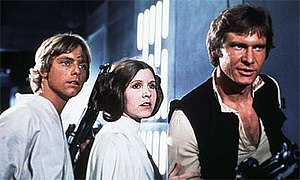Authors, Writers, Publishers, and Book Readers
The one thing that made the latest Star Wars movies (Episodes 1-3) not work for me was the terribly weak script. Everything else was spectacular except the dialogue. It was stilted, boring, uncomfortable, and above all, it lacked believability.

The three lead protagonists of Star Wars, from left to right: Luke Skywalker (Mark Hamill), Princess Leia (Carrie Fisher), and Han Solo (Harrison Ford). (Photo credit: Wikipedia)
The first Star Wars movie (Episode 4: A New Hope) is the one that sent my imagination and passion for storytelling into overdrive when I was eight years old because I completely believed in the characters and the brilliant, unique story. Luke Skywalker, Princess Leia, Chewbacca, Han Solo, Obi-Wan Kenobi, and Darth Vader all had very distinct personalities and they behaved accordingly in every situation they were in. Their responses to every predicament were believable – they were REAL! I bought it because I lived it with them; I was there with them every moment – being chased, shot at, tortured, swerving, diving, and rolling with the Millennium Falcon! It was awesome! But then came the disappointing prequels, which, for me, quite simply sucked in comparison.

Ewan McGregor (left) as Obi-Wan Kenobi and Hayden Christensen (right) as Anakin Skywalker in Attack of the Clones. (Photo credit: Wikipedia)
Is it because I’ve grown up? I asked myself over and over again. But the more I thought about it and analysed it the more I came to understand that, no, what was wrong was that the characters lacked any kind of credibility and normalcy.
Now how can fantastical characters be normal, you may ask? Isn’t the whole point of fiction that our characters are bigger than life (especially in Fantasy), that they, and the situations they find themselves in, are blown up out of proportion to elicit greater emotion for the reader, to draw them into the story and make them ‘see’ it and experience it, no matter how unreal the story? But tell me, how can you do that without making your characters relatable to the reader, and without creating characters they can understand? How can you expect a reader to become completely absorbed in your story if they can’t ‘see’ themselves there or ‘say the words’ your characters are saying without it being jarring thereby distracting them from the emotional aspect of the story, which shallow, forced dialogue does instantaneously? And then the reader loses interest because they cannot sense the integrity and ‘realness’ of the characters. These are questions I have to ask myself each time I write dialogue in my books.
My characters are like my best friends after creating them and writing them for three years now and counting. I know their personalities inside out, so when I write a scene I know exactly what they’re going to say and how they’re going to say it. I know their individual reactions and I know what they’re thinking, too. I can tell immediately if the dialogue isn’t working and if a particular character says something he or she would never say.
In Episodes 1-3 of Star Wars the characters are very tough, very strong, and very individual with distinct personalities, but the dialogue doesn’t match those personalities. Anakin Skywalker does not portray his anguish convincingly enough (granted, the acting isn’t great, either); his change from despairing Jedi into dark lord is pathetic, and the dialogue does nothing to make it real for me. I felt frustrated because I couldn’t ‘feel’ what he was going through – I couldn’t go on his terrible emotional journey with him and fully experience his turmoil as he murdered those Jedi children.
Isn’t that the task of every writer/film maker/poet/artist, to take the observer on an emotional journey with their characters/art? Isn’t that what makes a great story a best seller, a hit that leaves the public clamouring for more?
Yes, the otherworldly circumstances our fantastical characters find themselves in will never really exist, but their emotional experiences certainly do.
KC (my main character) will never be a Sword Bearer in real life and fight an Arch Demon in the coldness of space, but she will have fears and doubts and struggle to come to terms with who she is and deal with her unwanted responsibilities. When she argues with her brother, Khyl, and unleashes her anger on him for not caring about her and causing her so much pain, that’s REAL!! So when they’re dialoguing it has to sound convincing otherwise the reader won’t be able to get involved in the conversation and feel what KC is feeling and feel Khyl’s frustration and guilt!
I watched the latest Star Wars films from a distance and only thoroughly enjoyed the marvels of the special effects and the amazing artistry and costumes and music. But the characters were distant and cold, and I left the theatre feeling flat instead of uplifted and excited and fired-up as I felt after the first film. I missed the magic, the wonder, the adrenalin rush, the powerful longing to be in that world and partake of the awesomest adventure ever!
These are my personal tips for creating believable characters:
Get to know every single one of your characters intimately (if you’ve read my last blog – My Character and I Are One – a Journey into The Sword Bearers Series – you should know your characters are pieces of you, anyway!!); place yourself in their situation in every dialogue you write, and then write it like you mean it! Feel the emotions, the tensions, the subtleties; ‘see’ their actions – why don’t you act it out, if that helps?!! Or even speak it as you write it so that you can experience the emotion in the room – whether it be love, anger, passion, hatred, pain, tears . . . whatever it is live it for yourself! Dang, I cried when one of my main characters died! The scene was charged with overwhelming emotion and horror and grief, and my tears made the computer screen blurry as I wrote it. When that happened I absolutely KNEW my readers would cry, too!! It was powerful; the scene, the characters, lived!!
Two Excellent Blogs on Character Development
I’ve read two blogs this week about building believable characters that I feel I must share with you. The first one is by Victoria Grefer titled ‘Writing Believable Characters’, and the second by Codey Amprim from the Mythic Scribes website titled ‘Five Tips for Writing Kick-Ass Characters’. Do yourselves a favour and go read them. They offer more great tips on character development that will help you if you need it.
I love hearing from you. What do you do to get your characters to ‘live’, to become believable? Please share it with the class!
Related articles:
My Characters and I are One – a Journey into The Sword Bearers Series (www.moniquerockliffe.wordpress.com)
Comment
© 2025 Created by Authors.com.
Powered by
![]()





You need to be a member of Authors.com to add comments!
Join Authors.com